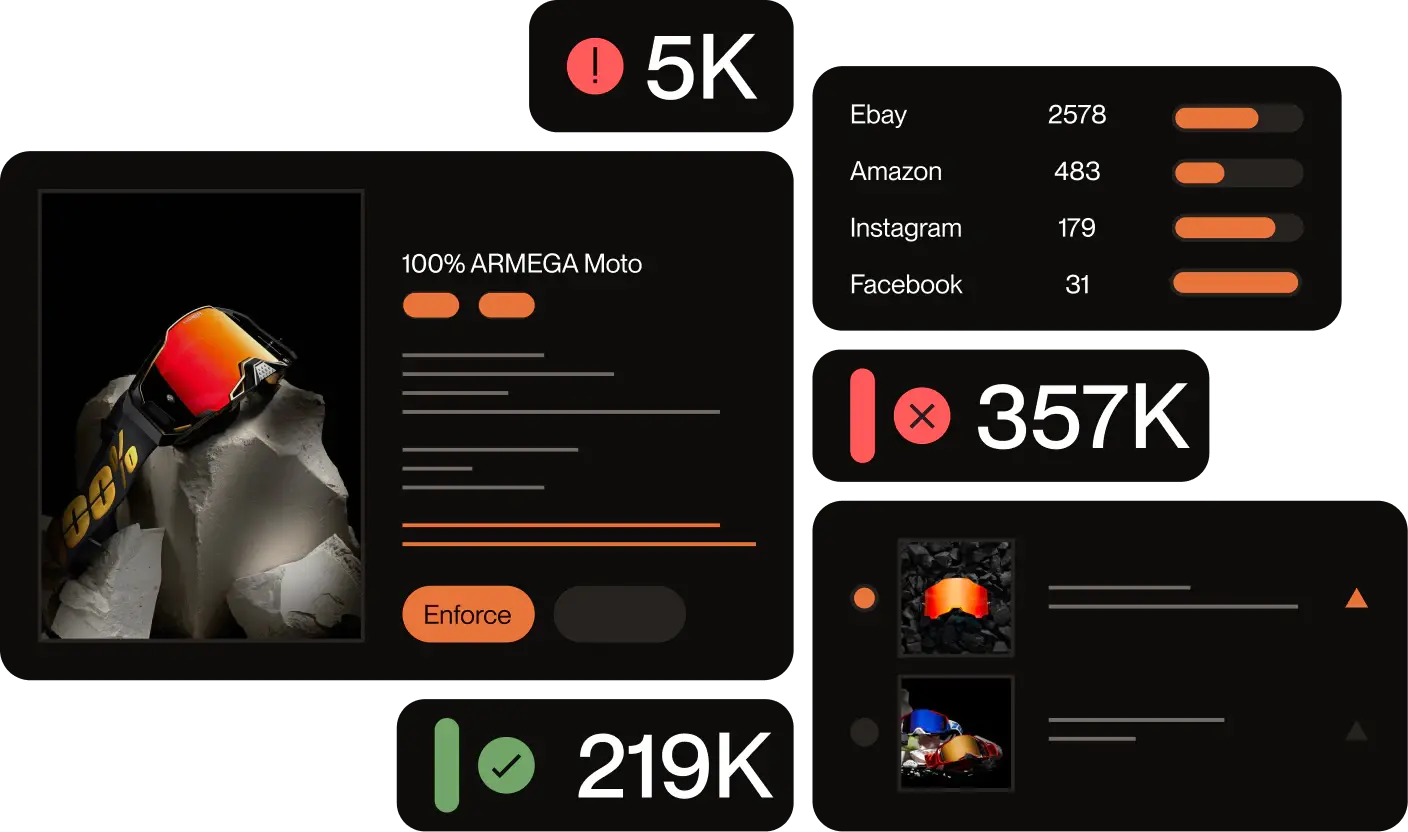Taking down a fake or harmful website shouldn’t be this difficult.
But if you’ve ever tried, you know the challenges: navigating complex legal requirements, dealing with unresponsive platforms, and figuring out who’s even responsible for hosting the site. Each step can feel like a maze, wasting valuable time while the fake website continues to harm your business and customers.
Without the right approach, the process can drag on for weeks—or even months—leaving your reputation and revenue at risk.
At Red Points, we’ve helped thousands of businesses tackle these challenges head-on. Drawing from our over 10 years of experience in brand protection, we’ve crafted a clear, effective approach to guide you through the process.
How to take down a website: Step-by-step legal guide
So, you just found out that your site has been impersonated by a scammer?
The first thing you should do is not to panic. Although domain squatting and spoofing can indeed be dangerous for your brand, there are ways to effectively handle the situation and legally take down the website.
You can do so by following this step-by-step guide:
Step 1: Investigate the website
The first step is to collect information about the website itself. Identify the registrar of the fake domain name. You can do this with WHOIS lookup tools like WhoIs.com and ICANN’s lookup tool. Be aware that many registrars shield the registrant’s personal information, so you might find generic information.
You should still see a name server address, though. You can search this in Google to see the hosting provider of the domain name.
Step 2: Collect evidence
The next step, regardless of whether you can identify the scammer, is to collect evidence of the fraudulent activities performed by the scammer via the fake website.
While there are advanced tools available for collecting websites, gathering screenshots (with timestamps) can be effective. You should collect evidence of at least the following:
- The website’s domain name
- IP address (or addresses)
- URL
- Any brand elements that may be a violation of any copyright/trademark policies
- Web pages that are similar to yours
- Any branding elements used on the fake website
- Proof of fraudulent activities (i.e., testimonials from victims)
The more pieces of evidence you can gather, the easier it will be to legally shut down the website.
Step 3: Report illegal and fake websites
Once you’ve gathered and compiled all the necessary evidence, you should file your report to the relevant parties:
- Google/other search engines: if you have proof that the website is engaging in criminal activities (i.e., phishing, impersonating your eCommerce store, etc.), quickly file your website report to Google’s safe browsing team and other relevant search engines (i.e., Bing.) This is to ensure the site can be penalized and won’t appear on search results to minimize the number of future victims.
- Relevant authorities: depending on your location, you may want to file a complaint on the illegal website with the local police department and the FBI.
- Domain registrar: check where the domain name is registered and report the situation. It’s possible that the scammer is registering the domain under your name (or business’s name). In such cases, report to ICANN and ask them to de-list your name. If the website is a Top Level Domain (TLD), for example, if they are using .com, .org, or .net, then you can report to ICANN here. If the website uses ccTLD (country code TLD) like .us, .uk, and so on, then you can check this list and contact the domain registrar of the relevant country used by the fake website.
- ICANN: if you have a registered trademark for your domain name, you can file a complaint under the UDPR (Uniform Domain-Name Dispute Resolution). Successful UDPR filing can result in the domain name ownership being transferred to you.
- Payment gateway: if the website involves online transactions and offers payment options like PayPal, credit card (Visa/MasterCard), Venmo, and so on, you can contact these payment companies and report the situation; they may also be willing (and capable) of helping you to take down fake websites.
All reports on websites should contain:
- Complete and accurate contact details of your business and a PIC
- All the evidence you’ve gathered
- A brief explanation of the situation (why you think the website is currently being impersonated.)
- The desired outcome you’d like from reporting the abuse (i.e., termination of responsible employee.)
Step 4: Send a cease and desist letter for illegal websites
Prepare a DMCA (Digital Millenium Copyright Act) notice, and then send an official cease and desist letter to the site admin. Alternatively, you can send the letter to the domain registrant if you can’t reach the fake website owner.
If you are dealing with a scammer/cybercriminal, most likely, you won’t get any response. Your next step is to send the letter to the CMS platform the fake website is built upon. Most scammers won’t build the website from scratch and will rely on platforms like Shopify, Wix, or WordPress. Most likely, these platforms will cooperate with you and shut down websites if you can prove the occurrence of criminal activities.
If the domain registrar or CMS platform still didn’t give their response, then you can send a cease and desist letter to the server host. Server hosts are required to comply with strict regulations and are more likely to be more cooperative in shutting the website down.
Step 5: Follow-up with Google
If you’ve followed this guide on shutting down websites legally to a T, then you should’ve sent a request to Google informing them of the situation, asking for the fake website to be removed from the search result.
Remember that Google receives a massive number of DMCA takedown requests every single day, so expect that the process of taking down a website may take a while, at least a few days up to a week.
You may want to follow up with a complete DMCA request, especially with proof that you are the legal copyright owner of the website and its content, as well as the evidence of the malicious activities on the fake website.
When should you consider an automated solution?
The steps above can take hours or days to complete if it’s your first time filing a takedown notice. Your time could be better spent on actions that directly grow the business, but you can’t neglect the issue of scammers taking advantage of your brand.
This is where an automated solution like Red Points comes in. Our platform uses capabilities like bot search, computer vision, and rules-based reasoning to scale takedowns.
Our predictive models learn about your brand and prioritize critical infringements. This saves you hours of work and multiplies the breadth of coverage.
Common challenges when shutting down a website and how to overcome them using Red Points
Unresponsive hosting providers
Some hosting providers take a long time to respond, while others purposely ignore copyright takedown notices because their clients make fake websites. If you’re dealing with this issue, make sure you document your case thoroughly with evidence of the infringement and your ownership. You can try getting the site deindexed from search engines and reporting fake ads you find on social media.
Red Points help speed up communication in this case as a member of Google’s Trusted Copyright Removal program. We also have more leverage to enforce compliance than individual brands.
Complex international regulations
Many scammers set up shop in countries with weak intellectual property laws. This can complicate enforcement across borders.
The best solution in this case is to work with a team that has experience with international IP law. Our team has global experts who deal with challenging jurisdictions regularly.
Anonymity through CDNs
Scammers can use content delivery networks (CDNs) to hide their IP addresses and publish content anonymously. We’ve found over half of infringing websites use proxy servers to obscure their identities.
In this situation, you can try to file a DMCA notice directly with the CDN. However, it may not respond. Our team has access to advanced tools that can help uncover a site’s origin and improve the likelihood of enforcement.
How long does it take to take down a website?
It can take anywhere from a day to a few weeks to get a website taken down depending on who you report it to and how responsive they are.
- If you can find the website owner, they could respond and take the site down in a few days to weeks.
- Filing a DMCA takedown notice with a responsive host can remove the site in as little as a day.
- A less responsive host could increase the time to a few weeks, especially if the website owner files a counter-notice.
- When dealing with Google, you should receive a response to your takedown request in a couple of business days, but it can take a week or more for the site to get deindexed.
- If the site owner disputes your request, it can take multiple weeks to work with lawyers and get the site taken down, especially over national lines.
Faster enforcement is another benefit to working with Red Points. Our system doesn’t just send one takedown notice at a time. We enforce on multiple fronts at once, and if a notice gets rejected, we escalate the enforcement.
We’ve sped up enforcement time by 22% in the past year, which means your reputation is secured that much faster when fake sites appear. The platform completes the vast majority—74%—of infringements automatically. So, you can know your brand is protected while you sleep.
Can you shut down a website permanently?
The reality is that the internet isn’t censored in most countries and people are free to make websites on almost anything they want. You can get a website taken down with a DMCA notice to the hosting provider, but the scammer behind the site could create a new one at a similar domain.
There isn’t a way to shut down a site and prevent other variations unless you can pay for a legal team working around the clock or you can leverage a solution like Red Points.
If you hire an IP rights lawyer or firm to send takedown notices on your behalf this can make takedowns more effective compared to writing your own. However, you still need a way to uncover new sites when they pop up, and that’s time-consuming and expensive to do manually.
With Red Points’ predictive models and comprehensive takedown tools, the platform searches for sites using your IP around the clock. It uses automated rules to enforce against infringing sites 24/7.
What’s the result? The scammer gets hit with enough takedown notices for your brand that they decide to move on to another target. They decide it isn’t worth it to put time into duplicating your site when it gets taken down so soon. This effectively deters that scam operation from using your brand’s IP in the future.
What’s next?
If you find a website infringing on your intellectual property, you have a legal basis to take it down. Start by investigating the website, collecting evidence, and reporting the site to the right place. In the best scenario, the owner or hosting provider complies quickly after a DMCA notice. But things don’t always go that smoothly.
You can leverage Red Points to automate takedown notices and monitor the web for new threats. Enforcing your IP requires vigilance, and using our AI brand protection platform is the best way to be proactive.
Don’t let infringing websites go unnoticed, especially if you have a growing brand. Reach out today for a demo to see how Red Points’ software can safeguard your brand’s reputation.








